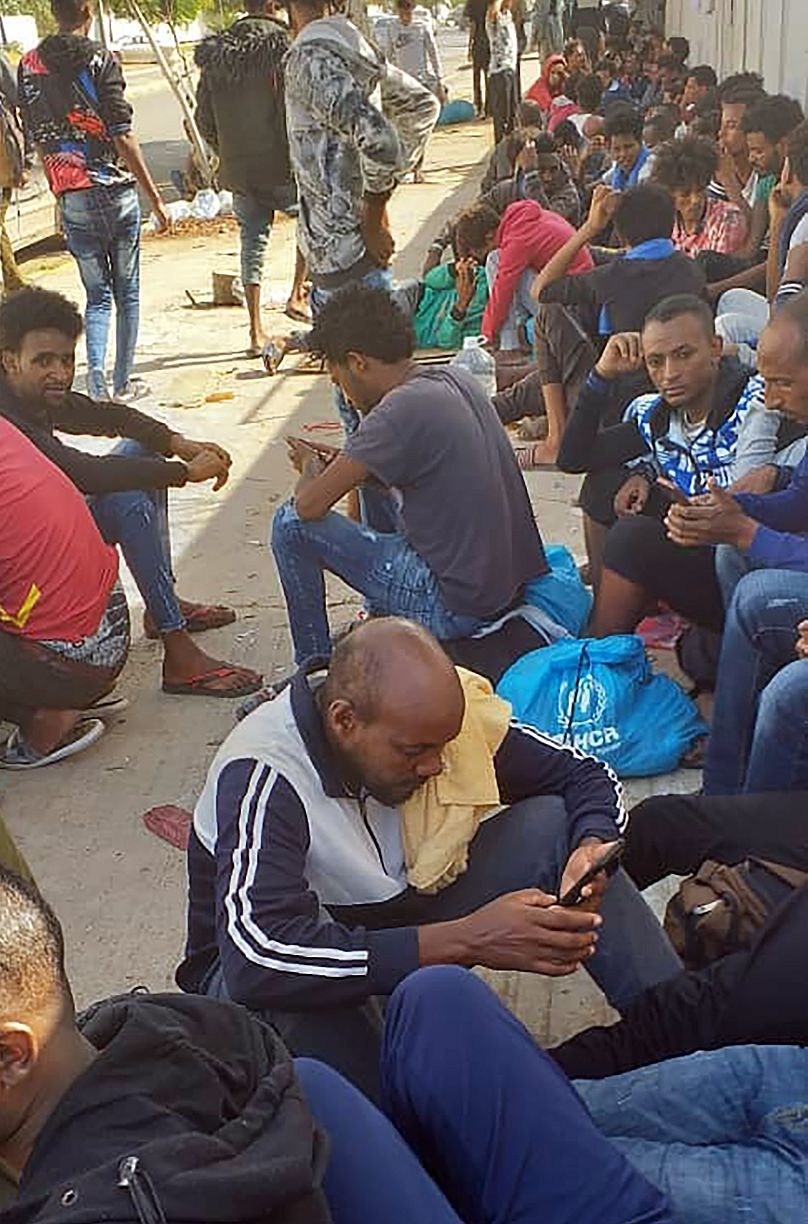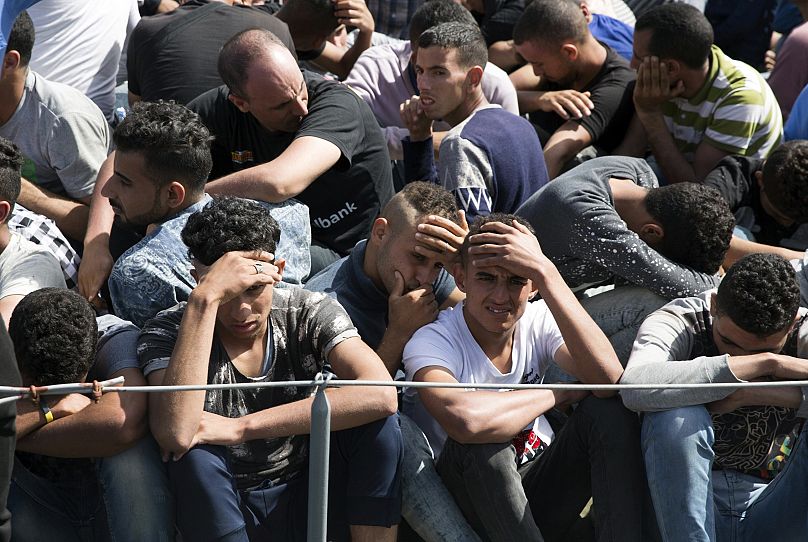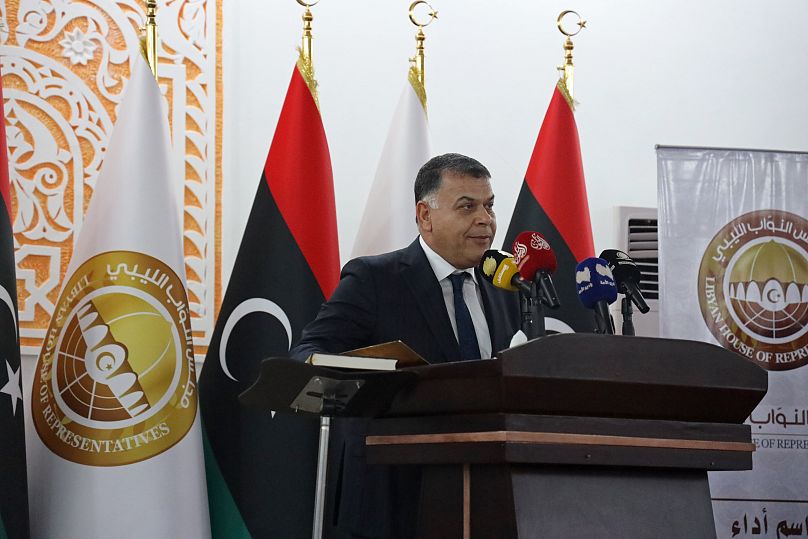The country's provisional government says it wants to end lawlessness in the camps, but migrants still dream of a life in Europe.
Libya has been closing its migrant detention centres despite concerns in Europe about rising numbers of people attempting the treacherous journey across the Mediterranean.
The reason, says the man in charge of running them, is that they are themselves a hotspot for smugglers.
Authorities believe the centres in al-Khums and Zawiya, both towns within a few hours’ drive of the capital Tripoli, were the very place where migrants would travel in order to buy their way into Europe.
They were also the scene of some gruesome abuses.
The centres ordered shut by the head of the Department for Combating Illegal Immigration (DCIM), which is part of Libya’s interior ministry.
Colonel Mabrouk Abd al-Hafiz, who runs the DCIM, said the closures would help disrupt smuggling networks and allow the provisional government to take greater control.
The reality is that many facilities were under the control of militias and conditions inside were deplorable.
Hotbeds of torture and violence
Euronews spoke to refugees and survivors in Tripoli who recounted acts of kidnapping for ransom, torture, sexual violence, forced labour and killing — all happening within these centres.
Libya’s provisional government was only formed two months ago after years of civil war devastated the country.
The conditions allowed corruption to flourish, Col Abd al-Hafiz said: “The problem is not only with the militiamen or the individuals taking advantage of the situation, but also with the lobby which is anchored in state institutions.
“This includes people from my own agency.”
There are currently 21 detention centres in Libya holding an estimated 3,000 migrants. Their history can be traced back to when the country was run by Muammar Gaddafi.
All were established to deter onward migration to Europe and all are, notionally at least, under the DCIM’s authority today. Moreover, EU efforts to work with Libyan authorities to improve conditions in the centres have so far been ineffective, according to human rights and aid groups.
Thousands of kilometres
In addition to those at al-Kums and Zawiya, another centre now closed was in the inland city of Zintan. Euronews visited it last December as it was being wound up.
At the time, many refugees recounted how they had been waiting for weeks for a safe transfer.
One had travelled around 3,500 kilometres from Eritrea in east Africa — the equivalent of a journey overland from Moscow to Madrid.
“Out of desperation, many refugees started to find their way to Tripoli,” said the Eritrean refugee, who was considering paying a smuggler for a lift to cover the remaining 165 km north to the Mediterranean coast.
Leaked internal emails between United Nations agencies suggest that the decision to move people out of Zintan was planned, and then postponed, multiple times.
Into the arms of smugglers
“DCIM have agreed to support the release and movement of 325 persons of concern to UNHCR [the United Nations refugee agency] from Zintan Detention Centre to Tripoli over the period of eight days starting on Monday, 7 December and until 16 December 2020,” one message reads.
But delays meant the plan was only put into action in January, by which time just 120 people were left waiting at the centre.
The emails show that as the UN and other international agencies in Libya struggled to coordinate a response plan, other refugees escaped using smuggler networks.
At other centres, the picture is significantly more grim.
In Zawiya, the Abu Issa Detention Centre is still open despite the recent order to shut it. Around 100 refugees including women and children remain.
One Moroccan former detainee told an internal UN report seen by Euronews that they were often stripped naked while being searched.
It is a picture seen around the country: thousands of migrants and refugees continue to be held with little sign of the provisional Libyan authorities’ plan to create safer, dignified alternatives to detention.
As other camps are opened
This year, a new refugee collection and return centre opened in Tripoli. Named Al-Mabani, it is in an area of Tripoli controlled by the militia leader Emad al Tarabulsi, who was appointed by Libya’s former prime minister to a senior position in the intelligence service.
Local rights groups say his militia is known to extort refugees and migrants, many of whom were reported missing after they were detained.
In some cases, refugees and migrants paid guards between 1,000 and 7,500 Libyan dinars (€185 - €1,390 at the official exchange rate) to secure their freedom.
In other cases they tried to escape, despite the risk of being shot or beaten.
According to international medical organisations that visited, detainees here have little natural light and ventilation, not enough food and clean drinking water, and limited access to toilets and showers.
Al-Mabani is also extremely violent: on April 8 a person was killed in a shooting, while two teenagers with gunshot wounds were transferred for urgent medical care by the non-governmental organisation Doctors Without Borders.
From conscription to detention
Twelve years earlier, he had travelled in a different direction – from East Africa to Israel – on foot, a punishing journey across the Sahara and the Sinai that took more than a month.
After seven years in Israel he was deported, as with many other unwanted Eritrean and Sudanese refugees, to Uganda.
He was recently released from Zintan, the inland detention centre, where he spent over two years in an overcrowded hangar with four barely functioning toilets, no shower and only sporadic access to water.
“I am lucky to survive from Zintan and come to Tripoli. I am lucky to be here and speak as a witness”, he told Euronews.
He lives now in Gargaresh, on the outskirts of Tripoli, among hundreds of people in overcrowded, unfinished buildings.
But there are very few resettlement flights these days. UNHCR estimates that of the 5,200 people in Libya needing resettlement so far this year, the agency has received just 830 direct pledges from Italy, Norway, Sweden or Canada.
No prospects for change
Eritreans like Tumzi have received a letter from the agency saying that “after carefully examining their situation”, it is not possible for them to be evacuated to a third country because the availability of places is very limited.
For Col Abd al-Hafiz, who leads the Libyan DCIM agency, it is UNCHR that is responsible for the situation.
“Frankly, we don't understand why UNHCR strives to prioritise people who have good incomes and decently live in cities, instead of evacuating those who are in deplorable conditions or detained for more than 3 years”, he said.
But for people like Tumzi, who spent years in detention, the feeling of abandonment and fear dominate their thoughts of the future.
“We are left with the only option to cross the sea. We are ignored by the international community. We are always waiting, but nothing.”














